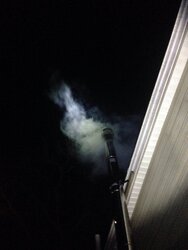So I just looked at my stack before bed and noticed that its smoking like a train. It's +1 deg f right now and I just loaded the stove with good dry hard wood and got it nice and hot before turning it down to go to sleep. I have an Englander 30 so I'm not used to seeing any smoke, I'm thinking it's not smoke but condensation or something since the smoke is very white in color and the air temp is so cold.
More smoke when it's cold?
- Thread starter Enplater
- Start date
-
Active since 1995, Hearth.com is THE place on the internet for free information and advice about wood stoves, pellet stoves and other energy saving equipment.
We strive to provide opinions, articles, discussions and history related to Hearth Products and in a more general sense, energy issues.
We promote the EFFICIENT, RESPONSIBLE, CLEAN and SAFE use of all fuels, whether renewable or fossil.


